The Suffolk coastal town of Lowestoft, known as the birthplace of the renowned British composer and birdwatcher Benjamin Britten, is currently grappling with a surge in the local kittiwake population. These seabirds, classified as endangered and red-listed, have increased dramatically in number, causing both practical and environmental challenges for the community.
Kittiwakes have been nesting in Lowestoft since the 1950s, initially colonising the town’s port entrance. However, their numbers have skyrocketed from approximately 650 in 2021 to nearly 2,000 in 2024. This increase has established Lowestoft as home to one of the United Kingdom’s most successful urban kittiwake colonies. Locally, this rise is especially pronounced during spring and summer when the birds return from their winter migrations in the North Atlantic to their birthplace to breed.
While the birds’ presence is a positive counterpoint to the global decline of kittiwakes—which has dropped by around 40 per cent since 1975 due to overfishing and climate change—their proliferation in Lowestoft has generated significant discomfort among residents and businesses. A recurring issue cited by locals involves the droppings of the kittiwakes, which are described as foul-smelling and unsightly. Mr Vino, owner of V&A Stores, remarked to the Daily Mail, "It stinks and it’s making a big mess. A few customers came into the shop last week and complained about the smell." Staff at his store reportedly spend up to two hours daily cleaning bird droppings from the windows and canopy.
The mess is also a concern for residents living near common nesting sites. Tony Shreeve, who has lived opposite the BT building for ten years, described the birds as "a bit hooligan-like," noting they "tear the place apart and go through the bins." Similarly, visitors to Lowestoft, including Shirley and Christopher Wyartt from Ipswich, have noticed the pervasive bird droppings. Mrs Wyartt described the situation: "It is just left on the ground. It is an eyesore."
In response to these issues, Lowestoft has adopted innovative measures to accommodate the growing kittiwake community while mitigating the impact on the town’s infrastructure. Artificial nesting sites, colloquially called 'kittiwake hotels,' have been constructed nearshore over the past two years. These installations are intended to provide alternative nesting options to reduce the birds’ presence on buildings. Notably, the local BT telephone exchange building replaced its netting—which had been used to deter the gulls—with specially designed nesting shelves.
Dick Houghton of the Lowestoft Seagull Action Group commented on the birds' behaviour and the challenges posed. "They've really come back in force now and it is more noticeable. If they were hatched in the town, they'd tend to return there. The more birds we have, the more mess," he explained. Houghton pointed out that the distinctive smell associated with the birds comes from the rotting fish they feed on. He also stressed that the purpose of the nesting hotels was not merely to accommodate the birds but to protect them from hazards such as wind turbines offshore.
There have been early signs of success with these initiatives. Ornithologists have used life-like decoy kittiwakes and recordings of the birds’ calls to encourage nesting in the artificial structures. Last year, a kittiwake chick was hatched at one of the hotels for the first time, raising hopes that the birds will increasingly chose these sites over urban buildings.
East Suffolk Council has acknowledged both the importance and difficulties of living alongside the kittiwakes. A council spokesman stated: "Businesses, and people living in Lowestoft, who are host to kittiwakes are playing a vital role in protecting vulnerable seabirds. However, we do appreciate that there are challenges associated with housing kittiwakes, including mess." The council organises regular pressure washing of public areas during nesting season to manage the bird droppings and supports local businesses through the Lowestoft Kittiwake Partnership by providing advice on how to minimise the impact of the birds.
Lowestoft’s experience reflects a complex balance between wildlife conservation and urban living. While the kittiwake colony’s growth reverses a global trend of decline, it also presents day-to-day challenges for the coastal community that continues to adapt to the presence of these seabirds.
Source: Noah Wire Services
